Essay 1: Strategies for Childhood Immunization Coverage in LMICs
VerifiedAdded on 2020/03/04
|9
|2255
|247
Essay
AI Summary
This essay analyzes interventions aimed at improving childhood immunization coverage in low- and middle-income countries (LMICs), based on a Cochrane review. It explores various strategies, including health education, financial incentives, and provider training, and examines their effectiveness. The essay discusses the study's methodology, including the PICOT table and risk of bias assessment, and summarizes key findings from the review. It identifies different types of interventions, such as recipient-oriented, provider-oriented, health-system-oriented, and multifaceted approaches. The essay also addresses implications for future research, highlighting gaps in evidence and suggesting areas for further investigation, such as the need for more adaptable recall interventions and community-based health education campaigns. The essay emphasizes the importance of multi-faceted and provider-oriented interventions and the implementation of vaccination coverage plans to reduce disease incidence. It concludes by acknowledging disagreements with other studies and identifying gaps in the current evidence base, such as the varying impact of face-to-face information and service alignment on immunization rates.
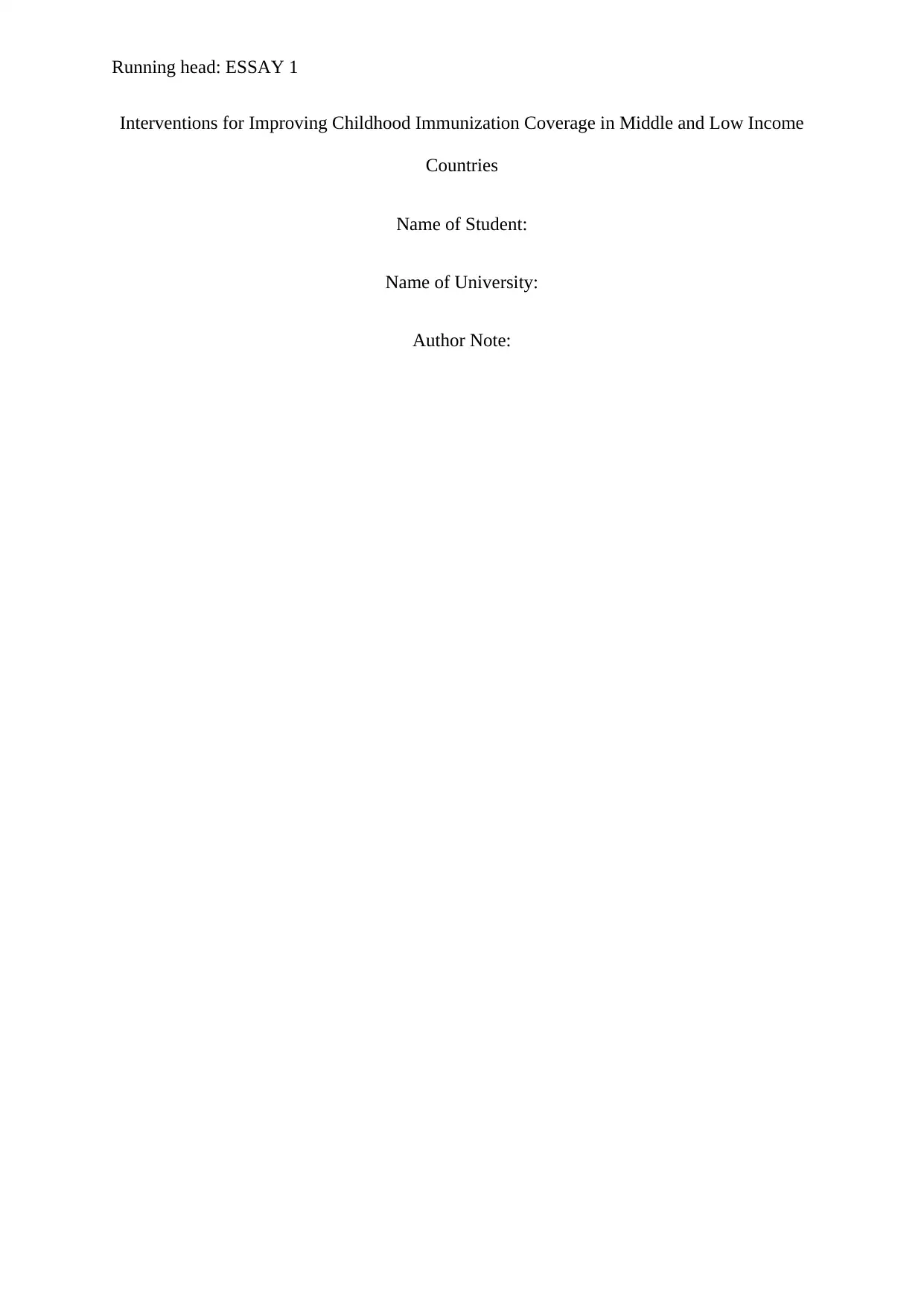
Running head: ESSAY 1
Interventions for Improving Childhood Immunization Coverage in Middle and Low Income
Countries
Name of Student:
Name of University:
Author Note:
Interventions for Improving Childhood Immunization Coverage in Middle and Low Income
Countries
Name of Student:
Name of University:
Author Note:
Paraphrase This Document
Need a fresh take? Get an instant paraphrase of this document with our AI Paraphraser
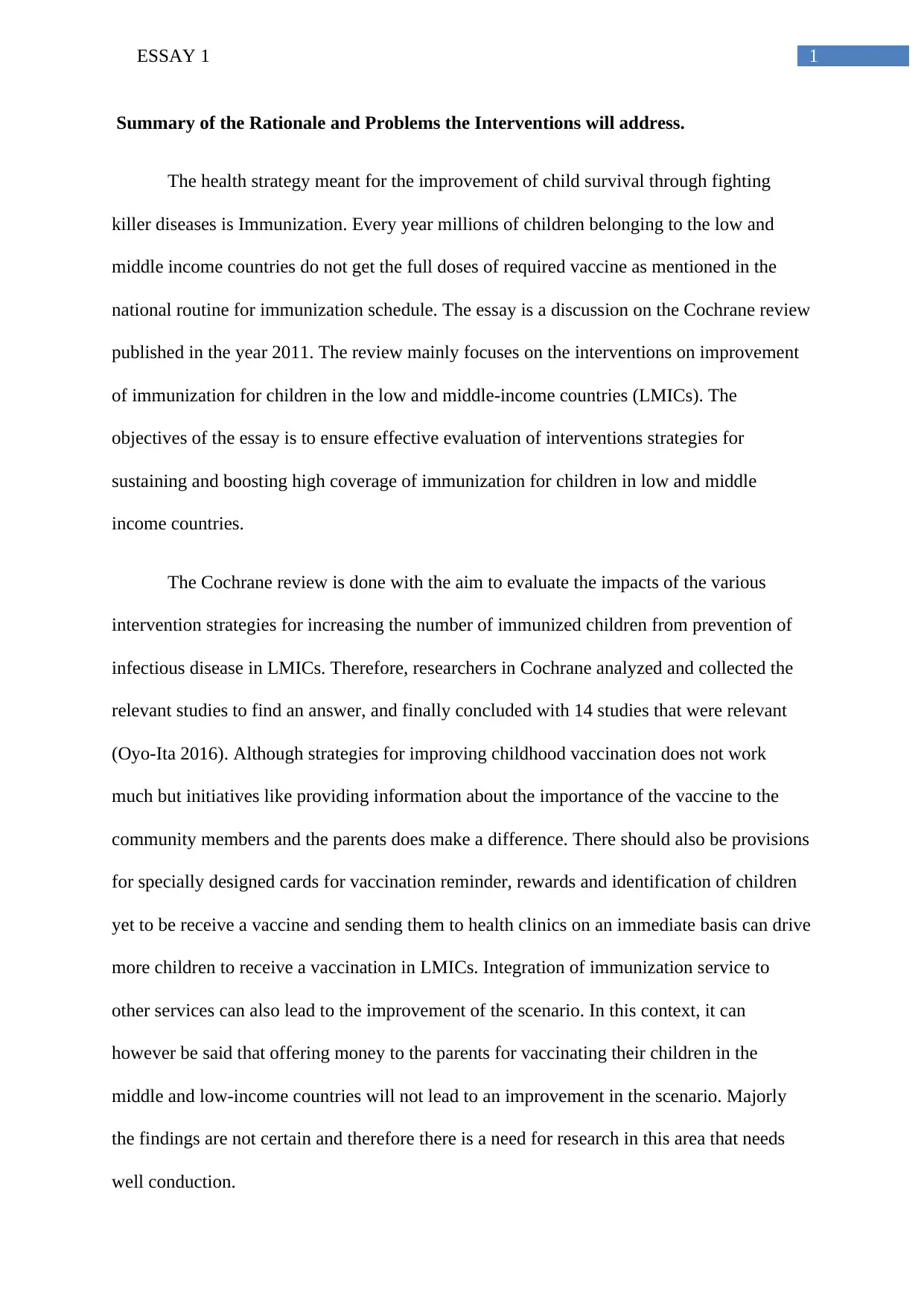
1ESSAY 1
Summary of the Rationale and Problems the Interventions will address.
The health strategy meant for the improvement of child survival through fighting
killer diseases is Immunization. Every year millions of children belonging to the low and
middle income countries do not get the full doses of required vaccine as mentioned in the
national routine for immunization schedule. The essay is a discussion on the Cochrane review
published in the year 2011. The review mainly focuses on the interventions on improvement
of immunization for children in the low and middle-income countries (LMICs). The
objectives of the essay is to ensure effective evaluation of interventions strategies for
sustaining and boosting high coverage of immunization for children in low and middle
income countries.
The Cochrane review is done with the aim to evaluate the impacts of the various
intervention strategies for increasing the number of immunized children from prevention of
infectious disease in LMICs. Therefore, researchers in Cochrane analyzed and collected the
relevant studies to find an answer, and finally concluded with 14 studies that were relevant
(Oyo-Ita 2016). Although strategies for improving childhood vaccination does not work
much but initiatives like providing information about the importance of the vaccine to the
community members and the parents does make a difference. There should also be provisions
for specially designed cards for vaccination reminder, rewards and identification of children
yet to be receive a vaccine and sending them to health clinics on an immediate basis can drive
more children to receive a vaccination in LMICs. Integration of immunization service to
other services can also lead to the improvement of the scenario. In this context, it can
however be said that offering money to the parents for vaccinating their children in the
middle and low-income countries will not lead to an improvement in the scenario. Majorly
the findings are not certain and therefore there is a need for research in this area that needs
well conduction.
Summary of the Rationale and Problems the Interventions will address.
The health strategy meant for the improvement of child survival through fighting
killer diseases is Immunization. Every year millions of children belonging to the low and
middle income countries do not get the full doses of required vaccine as mentioned in the
national routine for immunization schedule. The essay is a discussion on the Cochrane review
published in the year 2011. The review mainly focuses on the interventions on improvement
of immunization for children in the low and middle-income countries (LMICs). The
objectives of the essay is to ensure effective evaluation of interventions strategies for
sustaining and boosting high coverage of immunization for children in low and middle
income countries.
The Cochrane review is done with the aim to evaluate the impacts of the various
intervention strategies for increasing the number of immunized children from prevention of
infectious disease in LMICs. Therefore, researchers in Cochrane analyzed and collected the
relevant studies to find an answer, and finally concluded with 14 studies that were relevant
(Oyo-Ita 2016). Although strategies for improving childhood vaccination does not work
much but initiatives like providing information about the importance of the vaccine to the
community members and the parents does make a difference. There should also be provisions
for specially designed cards for vaccination reminder, rewards and identification of children
yet to be receive a vaccine and sending them to health clinics on an immediate basis can drive
more children to receive a vaccination in LMICs. Integration of immunization service to
other services can also lead to the improvement of the scenario. In this context, it can
however be said that offering money to the parents for vaccinating their children in the
middle and low-income countries will not lead to an improvement in the scenario. Majorly
the findings are not certain and therefore there is a need for research in this area that needs
well conduction.
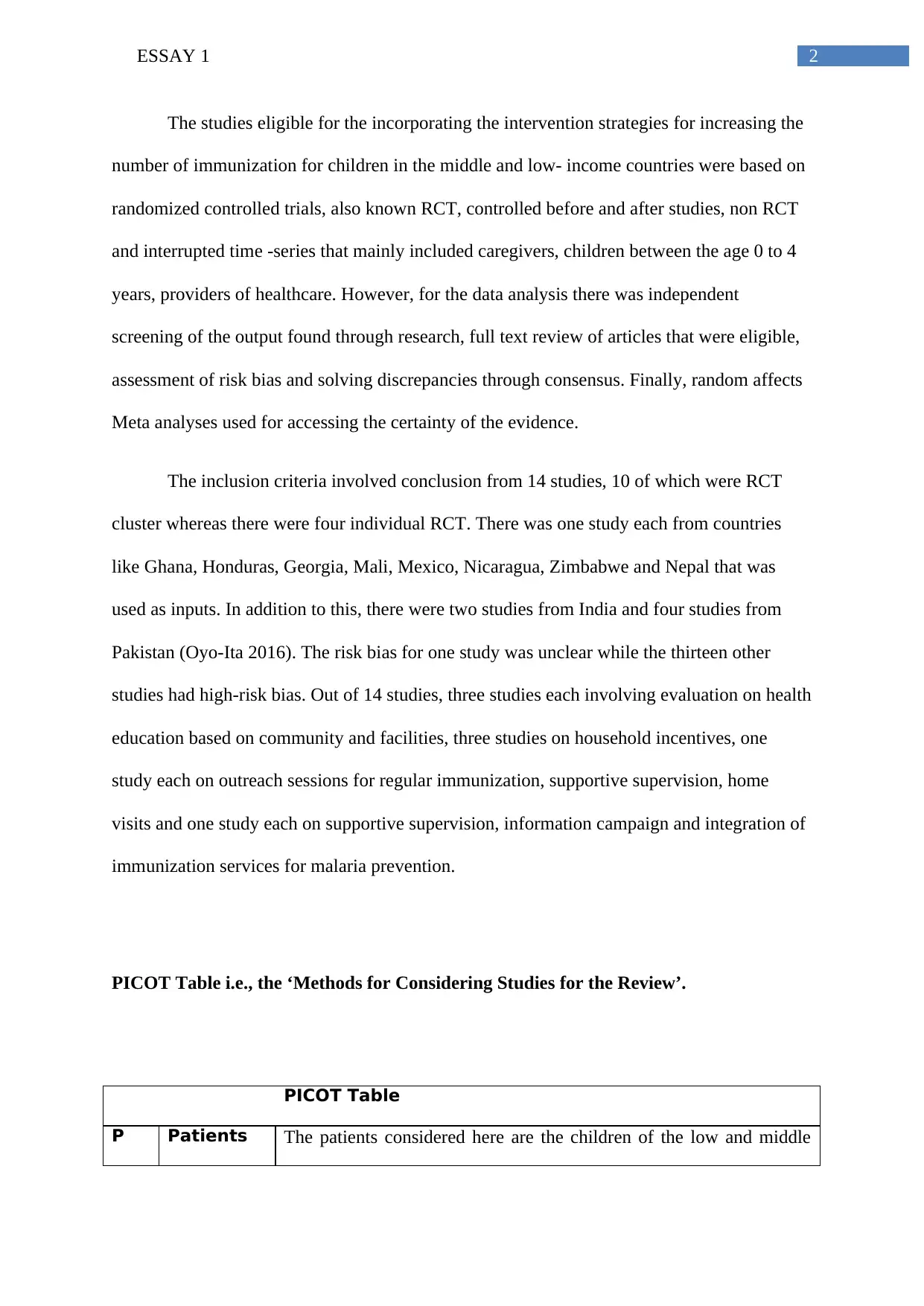
2ESSAY 1
The studies eligible for the incorporating the intervention strategies for increasing the
number of immunization for children in the middle and low- income countries were based on
randomized controlled trials, also known RCT, controlled before and after studies, non RCT
and interrupted time -series that mainly included caregivers, children between the age 0 to 4
years, providers of healthcare. However, for the data analysis there was independent
screening of the output found through research, full text review of articles that were eligible,
assessment of risk bias and solving discrepancies through consensus. Finally, random affects
Meta analyses used for accessing the certainty of the evidence.
The inclusion criteria involved conclusion from 14 studies, 10 of which were RCT
cluster whereas there were four individual RCT. There was one study each from countries
like Ghana, Honduras, Georgia, Mali, Mexico, Nicaragua, Zimbabwe and Nepal that was
used as inputs. In addition to this, there were two studies from India and four studies from
Pakistan (Oyo-Ita 2016). The risk bias for one study was unclear while the thirteen other
studies had high-risk bias. Out of 14 studies, three studies each involving evaluation on health
education based on community and facilities, three studies on household incentives, one
study each on outreach sessions for regular immunization, supportive supervision, home
visits and one study each on supportive supervision, information campaign and integration of
immunization services for malaria prevention.
PICOT Table i.e., the ‘Methods for Considering Studies for the Review’.
PICOT Table
P Patients The patients considered here are the children of the low and middle
The studies eligible for the incorporating the intervention strategies for increasing the
number of immunization for children in the middle and low- income countries were based on
randomized controlled trials, also known RCT, controlled before and after studies, non RCT
and interrupted time -series that mainly included caregivers, children between the age 0 to 4
years, providers of healthcare. However, for the data analysis there was independent
screening of the output found through research, full text review of articles that were eligible,
assessment of risk bias and solving discrepancies through consensus. Finally, random affects
Meta analyses used for accessing the certainty of the evidence.
The inclusion criteria involved conclusion from 14 studies, 10 of which were RCT
cluster whereas there were four individual RCT. There was one study each from countries
like Ghana, Honduras, Georgia, Mali, Mexico, Nicaragua, Zimbabwe and Nepal that was
used as inputs. In addition to this, there were two studies from India and four studies from
Pakistan (Oyo-Ita 2016). The risk bias for one study was unclear while the thirteen other
studies had high-risk bias. Out of 14 studies, three studies each involving evaluation on health
education based on community and facilities, three studies on household incentives, one
study each on outreach sessions for regular immunization, supportive supervision, home
visits and one study each on supportive supervision, information campaign and integration of
immunization services for malaria prevention.
PICOT Table i.e., the ‘Methods for Considering Studies for the Review’.
PICOT Table
P Patients The patients considered here are the children of the low and middle
⊘ This is a preview!⊘
Do you want full access?
Subscribe today to unlock all pages.

Trusted by 1+ million students worldwide
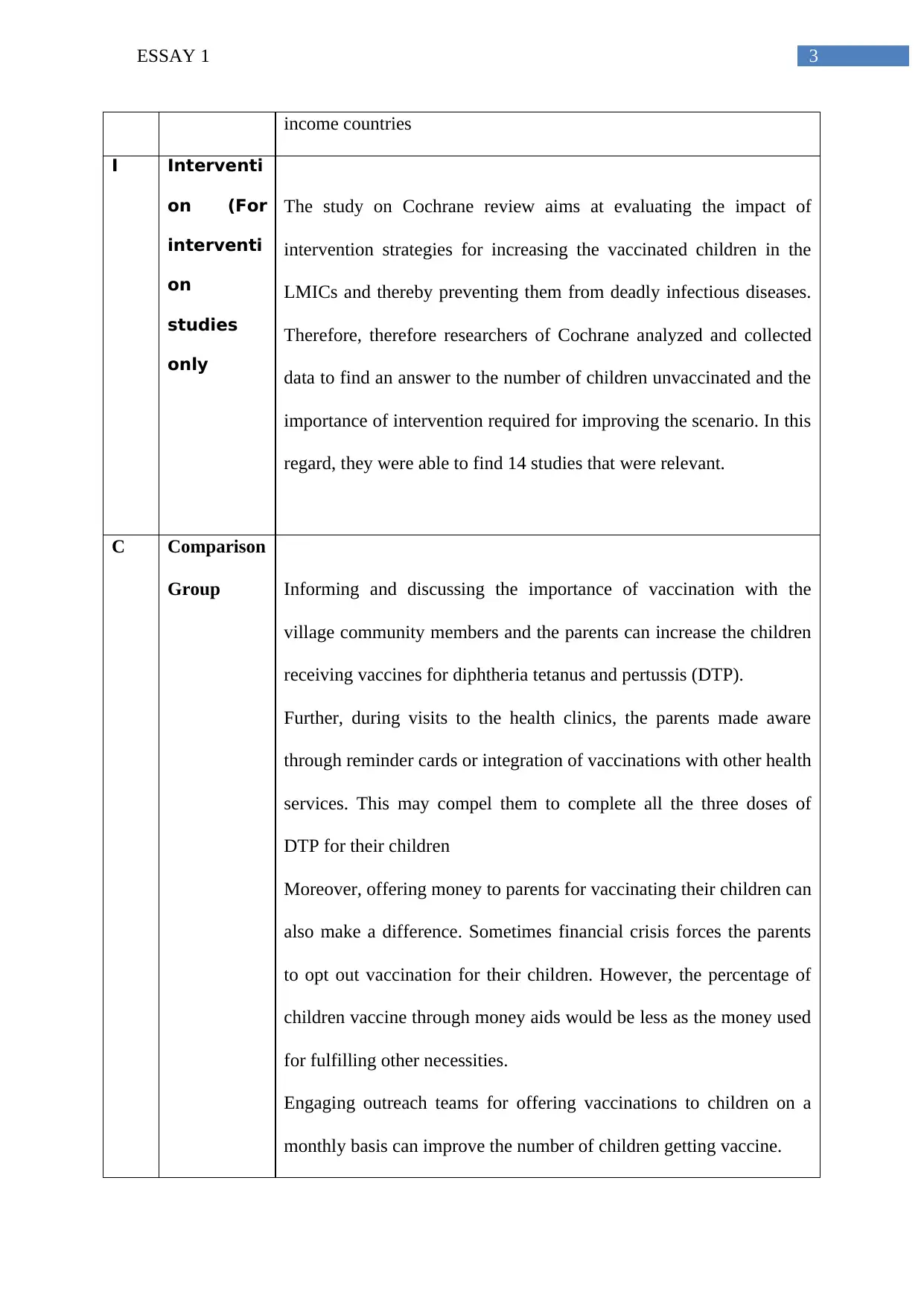
3ESSAY 1
income countries
I Interventi
on (For
interventi
on
studies
only
The study on Cochrane review aims at evaluating the impact of
intervention strategies for increasing the vaccinated children in the
LMICs and thereby preventing them from deadly infectious diseases.
Therefore, therefore researchers of Cochrane analyzed and collected
data to find an answer to the number of children unvaccinated and the
importance of intervention required for improving the scenario. In this
regard, they were able to find 14 studies that were relevant.
C Comparison
Group Informing and discussing the importance of vaccination with the
village community members and the parents can increase the children
receiving vaccines for diphtheria tetanus and pertussis (DTP).
Further, during visits to the health clinics, the parents made aware
through reminder cards or integration of vaccinations with other health
services. This may compel them to complete all the three doses of
DTP for their children
Moreover, offering money to parents for vaccinating their children can
also make a difference. Sometimes financial crisis forces the parents
to opt out vaccination for their children. However, the percentage of
children vaccine through money aids would be less as the money used
for fulfilling other necessities.
Engaging outreach teams for offering vaccinations to children on a
monthly basis can improve the number of children getting vaccine.
income countries
I Interventi
on (For
interventi
on
studies
only
The study on Cochrane review aims at evaluating the impact of
intervention strategies for increasing the vaccinated children in the
LMICs and thereby preventing them from deadly infectious diseases.
Therefore, therefore researchers of Cochrane analyzed and collected
data to find an answer to the number of children unvaccinated and the
importance of intervention required for improving the scenario. In this
regard, they were able to find 14 studies that were relevant.
C Comparison
Group Informing and discussing the importance of vaccination with the
village community members and the parents can increase the children
receiving vaccines for diphtheria tetanus and pertussis (DTP).
Further, during visits to the health clinics, the parents made aware
through reminder cards or integration of vaccinations with other health
services. This may compel them to complete all the three doses of
DTP for their children
Moreover, offering money to parents for vaccinating their children can
also make a difference. Sometimes financial crisis forces the parents
to opt out vaccination for their children. However, the percentage of
children vaccine through money aids would be less as the money used
for fulfilling other necessities.
Engaging outreach teams for offering vaccinations to children on a
monthly basis can improve the number of children getting vaccine.
Paraphrase This Document
Need a fresh take? Get an instant paraphrase of this document with our AI Paraphraser
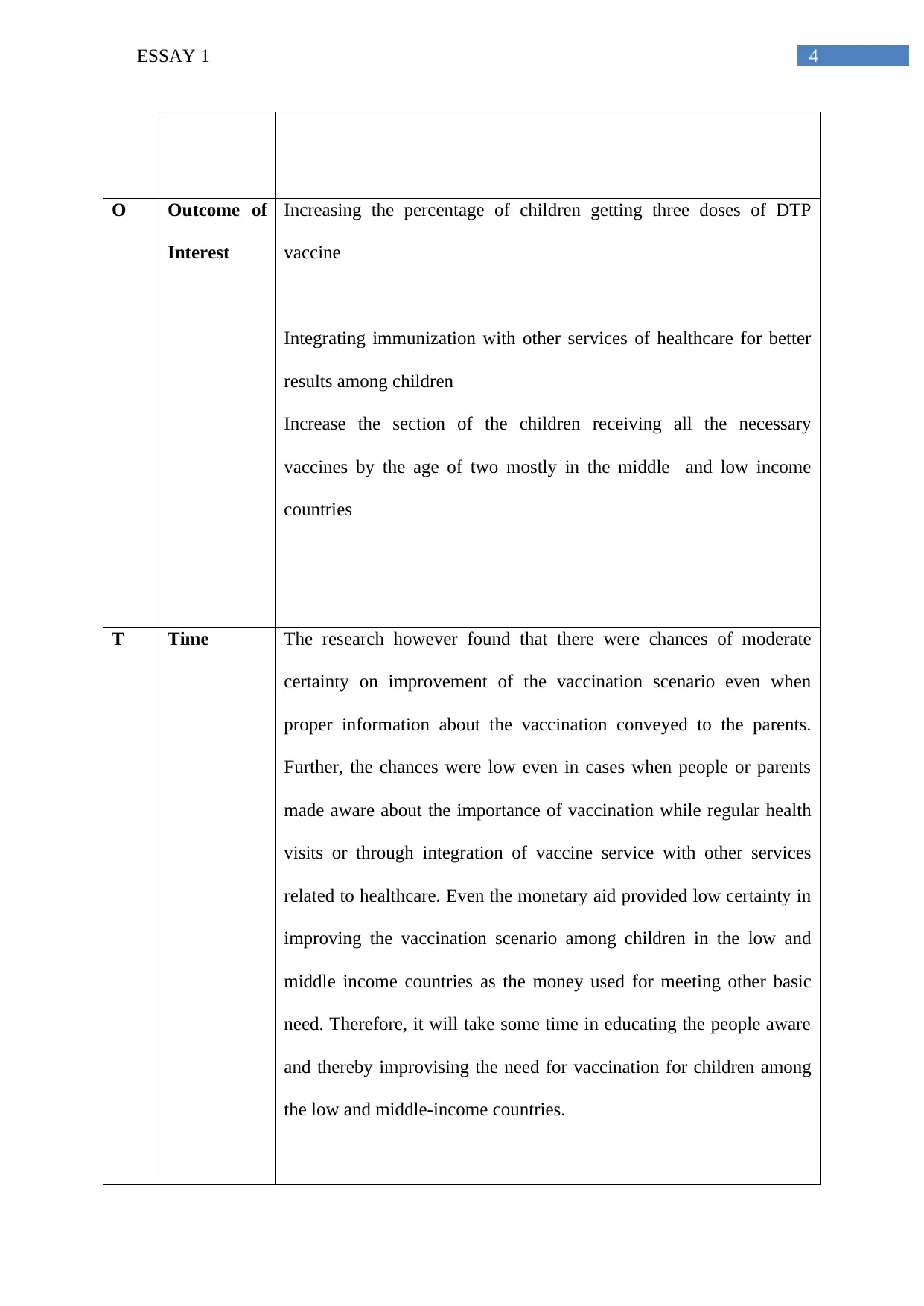
4ESSAY 1
O Outcome of
Interest
Increasing the percentage of children getting three doses of DTP
vaccine
Integrating immunization with other services of healthcare for better
results among children
Increase the section of the children receiving all the necessary
vaccines by the age of two mostly in the middle and low income
countries
T Time The research however found that there were chances of moderate
certainty on improvement of the vaccination scenario even when
proper information about the vaccination conveyed to the parents.
Further, the chances were low even in cases when people or parents
made aware about the importance of vaccination while regular health
visits or through integration of vaccine service with other services
related to healthcare. Even the monetary aid provided low certainty in
improving the vaccination scenario among children in the low and
middle income countries as the money used for meeting other basic
need. Therefore, it will take some time in educating the people aware
and thereby improvising the need for vaccination for children among
the low and middle-income countries.
O Outcome of
Interest
Increasing the percentage of children getting three doses of DTP
vaccine
Integrating immunization with other services of healthcare for better
results among children
Increase the section of the children receiving all the necessary
vaccines by the age of two mostly in the middle and low income
countries
T Time The research however found that there were chances of moderate
certainty on improvement of the vaccination scenario even when
proper information about the vaccination conveyed to the parents.
Further, the chances were low even in cases when people or parents
made aware about the importance of vaccination while regular health
visits or through integration of vaccine service with other services
related to healthcare. Even the monetary aid provided low certainty in
improving the vaccination scenario among children in the low and
middle income countries as the money used for meeting other basic
need. Therefore, it will take some time in educating the people aware
and thereby improvising the need for vaccination for children among
the low and middle-income countries.
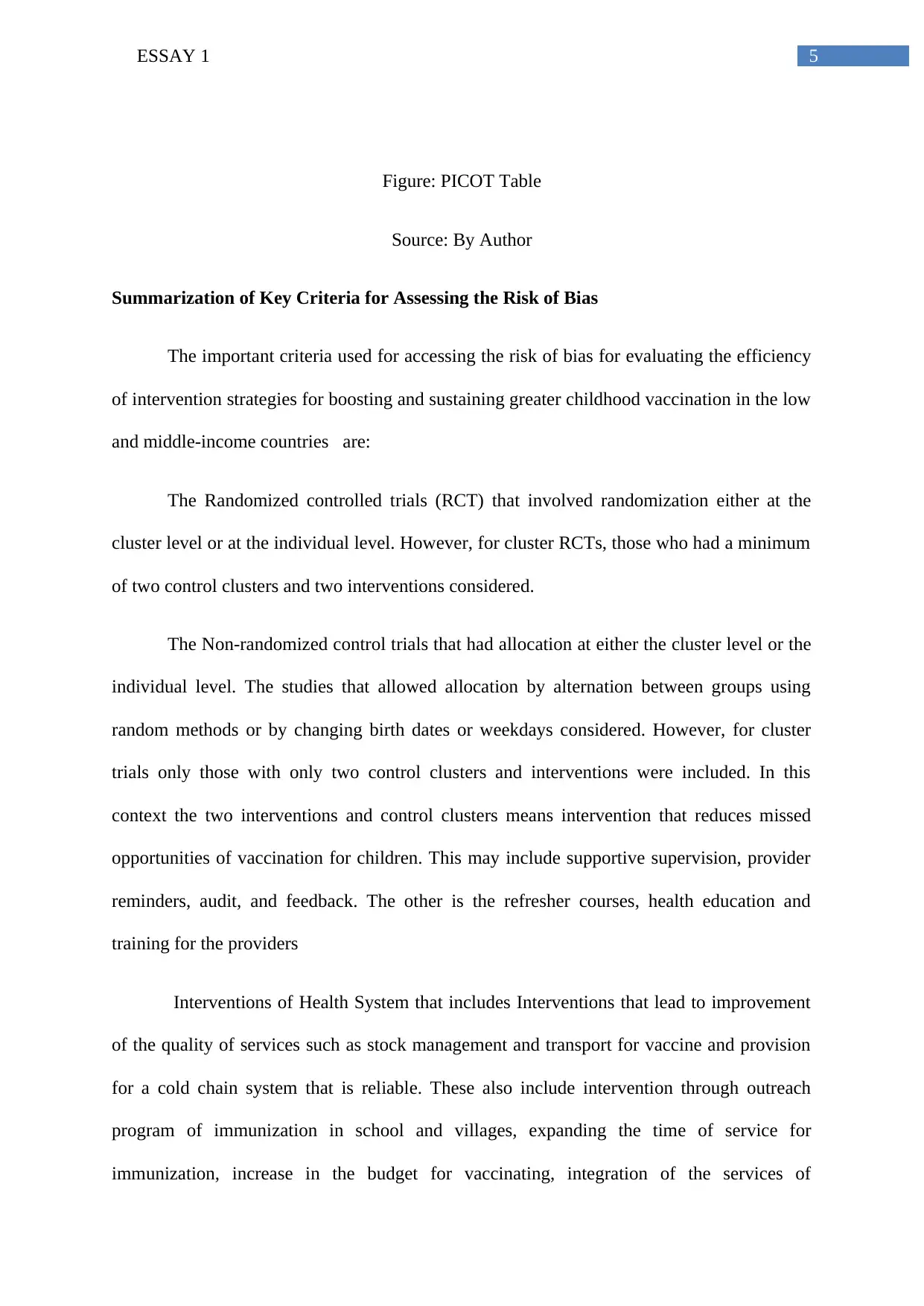
5ESSAY 1
Figure: PICOT Table
Source: By Author
Summarization of Key Criteria for Assessing the Risk of Bias
The important criteria used for accessing the risk of bias for evaluating the efficiency
of intervention strategies for boosting and sustaining greater childhood vaccination in the low
and middle-income countries are:
The Randomized controlled trials (RCT) that involved randomization either at the
cluster level or at the individual level. However, for cluster RCTs, those who had a minimum
of two control clusters and two interventions considered.
The Non-randomized control trials that had allocation at either the cluster level or the
individual level. The studies that allowed allocation by alternation between groups using
random methods or by changing birth dates or weekdays considered. However, for cluster
trials only those with only two control clusters and interventions were included. In this
context the two interventions and control clusters means intervention that reduces missed
opportunities of vaccination for children. This may include supportive supervision, provider
reminders, audit, and feedback. The other is the refresher courses, health education and
training for the providers
Interventions of Health System that includes Interventions that lead to improvement
of the quality of services such as stock management and transport for vaccine and provision
for a cold chain system that is reliable. These also include intervention through outreach
program of immunization in school and villages, expanding the time of service for
immunization, increase in the budget for vaccinating, integration of the services of
Figure: PICOT Table
Source: By Author
Summarization of Key Criteria for Assessing the Risk of Bias
The important criteria used for accessing the risk of bias for evaluating the efficiency
of intervention strategies for boosting and sustaining greater childhood vaccination in the low
and middle-income countries are:
The Randomized controlled trials (RCT) that involved randomization either at the
cluster level or at the individual level. However, for cluster RCTs, those who had a minimum
of two control clusters and two interventions considered.
The Non-randomized control trials that had allocation at either the cluster level or the
individual level. The studies that allowed allocation by alternation between groups using
random methods or by changing birth dates or weekdays considered. However, for cluster
trials only those with only two control clusters and interventions were included. In this
context the two interventions and control clusters means intervention that reduces missed
opportunities of vaccination for children. This may include supportive supervision, provider
reminders, audit, and feedback. The other is the refresher courses, health education and
training for the providers
Interventions of Health System that includes Interventions that lead to improvement
of the quality of services such as stock management and transport for vaccine and provision
for a cold chain system that is reliable. These also include intervention through outreach
program of immunization in school and villages, expanding the time of service for
immunization, increase in the budget for vaccinating, integration of the services of
⊘ This is a preview!⊘
Do you want full access?
Subscribe today to unlock all pages.

Trusted by 1+ million students worldwide
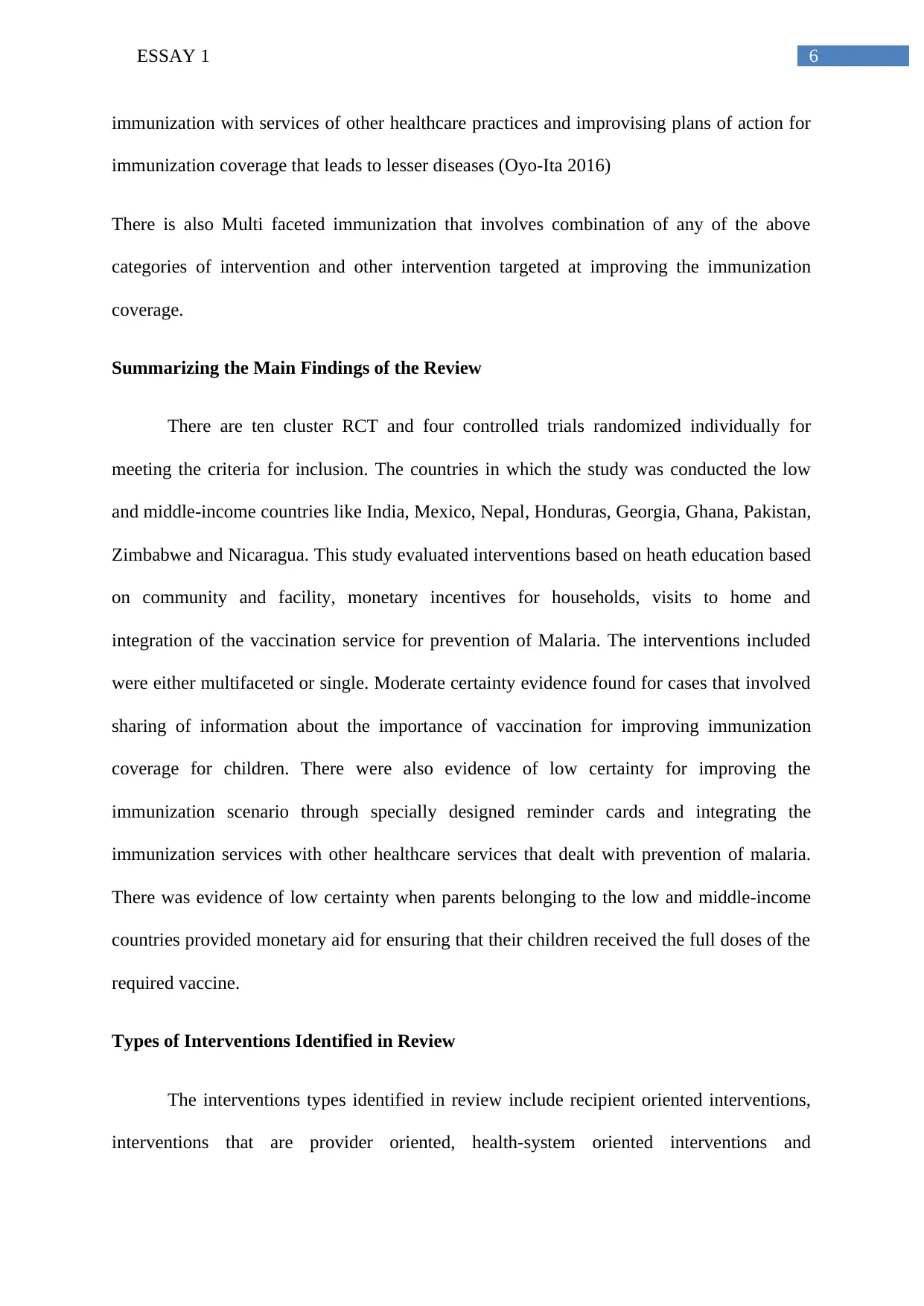
6ESSAY 1
immunization with services of other healthcare practices and improvising plans of action for
immunization coverage that leads to lesser diseases (Oyo-Ita 2016)
There is also Multi faceted immunization that involves combination of any of the above
categories of intervention and other intervention targeted at improving the immunization
coverage.
Summarizing the Main Findings of the Review
There are ten cluster RCT and four controlled trials randomized individually for
meeting the criteria for inclusion. The countries in which the study was conducted the low
and middle-income countries like India, Mexico, Nepal, Honduras, Georgia, Ghana, Pakistan,
Zimbabwe and Nicaragua. This study evaluated interventions based on heath education based
on community and facility, monetary incentives for households, visits to home and
integration of the vaccination service for prevention of Malaria. The interventions included
were either multifaceted or single. Moderate certainty evidence found for cases that involved
sharing of information about the importance of vaccination for improving immunization
coverage for children. There were also evidence of low certainty for improving the
immunization scenario through specially designed reminder cards and integrating the
immunization services with other healthcare services that dealt with prevention of malaria.
There was evidence of low certainty when parents belonging to the low and middle-income
countries provided monetary aid for ensuring that their children received the full doses of the
required vaccine.
Types of Interventions Identified in Review
The interventions types identified in review include recipient oriented interventions,
interventions that are provider oriented, health-system oriented interventions and
immunization with services of other healthcare practices and improvising plans of action for
immunization coverage that leads to lesser diseases (Oyo-Ita 2016)
There is also Multi faceted immunization that involves combination of any of the above
categories of intervention and other intervention targeted at improving the immunization
coverage.
Summarizing the Main Findings of the Review
There are ten cluster RCT and four controlled trials randomized individually for
meeting the criteria for inclusion. The countries in which the study was conducted the low
and middle-income countries like India, Mexico, Nepal, Honduras, Georgia, Ghana, Pakistan,
Zimbabwe and Nicaragua. This study evaluated interventions based on heath education based
on community and facility, monetary incentives for households, visits to home and
integration of the vaccination service for prevention of Malaria. The interventions included
were either multifaceted or single. Moderate certainty evidence found for cases that involved
sharing of information about the importance of vaccination for improving immunization
coverage for children. There were also evidence of low certainty for improving the
immunization scenario through specially designed reminder cards and integrating the
immunization services with other healthcare services that dealt with prevention of malaria.
There was evidence of low certainty when parents belonging to the low and middle-income
countries provided monetary aid for ensuring that their children received the full doses of the
required vaccine.
Types of Interventions Identified in Review
The interventions types identified in review include recipient oriented interventions,
interventions that are provider oriented, health-system oriented interventions and
Paraphrase This Document
Need a fresh take? Get an instant paraphrase of this document with our AI Paraphraser
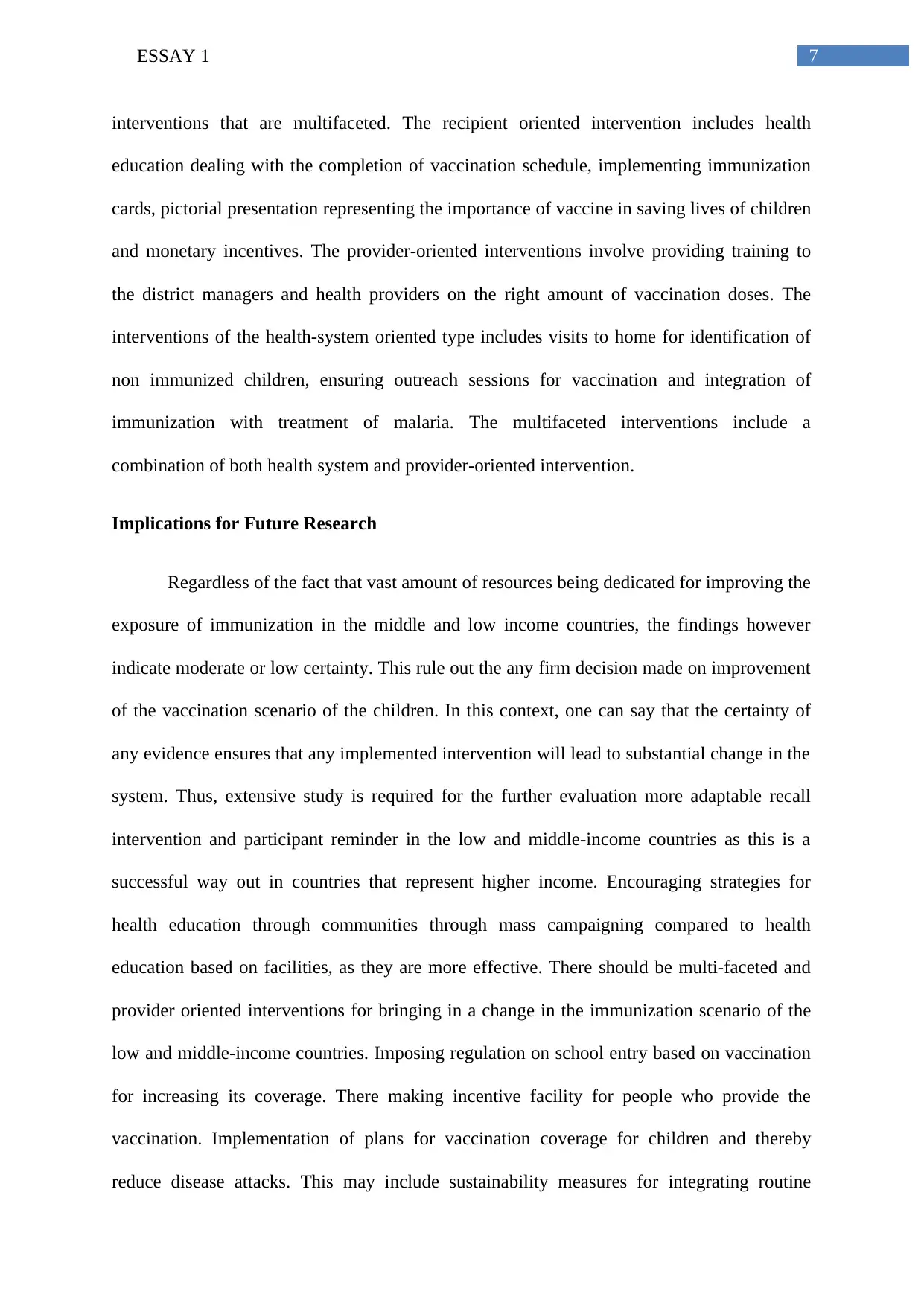
7ESSAY 1
interventions that are multifaceted. The recipient oriented intervention includes health
education dealing with the completion of vaccination schedule, implementing immunization
cards, pictorial presentation representing the importance of vaccine in saving lives of children
and monetary incentives. The provider-oriented interventions involve providing training to
the district managers and health providers on the right amount of vaccination doses. The
interventions of the health-system oriented type includes visits to home for identification of
non immunized children, ensuring outreach sessions for vaccination and integration of
immunization with treatment of malaria. The multifaceted interventions include a
combination of both health system and provider-oriented intervention.
Implications for Future Research
Regardless of the fact that vast amount of resources being dedicated for improving the
exposure of immunization in the middle and low income countries, the findings however
indicate moderate or low certainty. This rule out the any firm decision made on improvement
of the vaccination scenario of the children. In this context, one can say that the certainty of
any evidence ensures that any implemented intervention will lead to substantial change in the
system. Thus, extensive study is required for the further evaluation more adaptable recall
intervention and participant reminder in the low and middle-income countries as this is a
successful way out in countries that represent higher income. Encouraging strategies for
health education through communities through mass campaigning compared to health
education based on facilities, as they are more effective. There should be multi-faceted and
provider oriented interventions for bringing in a change in the immunization scenario of the
low and middle-income countries. Imposing regulation on school entry based on vaccination
for increasing its coverage. There making incentive facility for people who provide the
vaccination. Implementation of plans for vaccination coverage for children and thereby
reduce disease attacks. This may include sustainability measures for integrating routine
interventions that are multifaceted. The recipient oriented intervention includes health
education dealing with the completion of vaccination schedule, implementing immunization
cards, pictorial presentation representing the importance of vaccine in saving lives of children
and monetary incentives. The provider-oriented interventions involve providing training to
the district managers and health providers on the right amount of vaccination doses. The
interventions of the health-system oriented type includes visits to home for identification of
non immunized children, ensuring outreach sessions for vaccination and integration of
immunization with treatment of malaria. The multifaceted interventions include a
combination of both health system and provider-oriented intervention.
Implications for Future Research
Regardless of the fact that vast amount of resources being dedicated for improving the
exposure of immunization in the middle and low income countries, the findings however
indicate moderate or low certainty. This rule out the any firm decision made on improvement
of the vaccination scenario of the children. In this context, one can say that the certainty of
any evidence ensures that any implemented intervention will lead to substantial change in the
system. Thus, extensive study is required for the further evaluation more adaptable recall
intervention and participant reminder in the low and middle-income countries as this is a
successful way out in countries that represent higher income. Encouraging strategies for
health education through communities through mass campaigning compared to health
education based on facilities, as they are more effective. There should be multi-faceted and
provider oriented interventions for bringing in a change in the immunization scenario of the
low and middle-income countries. Imposing regulation on school entry based on vaccination
for increasing its coverage. There making incentive facility for people who provide the
vaccination. Implementation of plans for vaccination coverage for children and thereby
reduce disease attacks. This may include sustainability measures for integrating routine
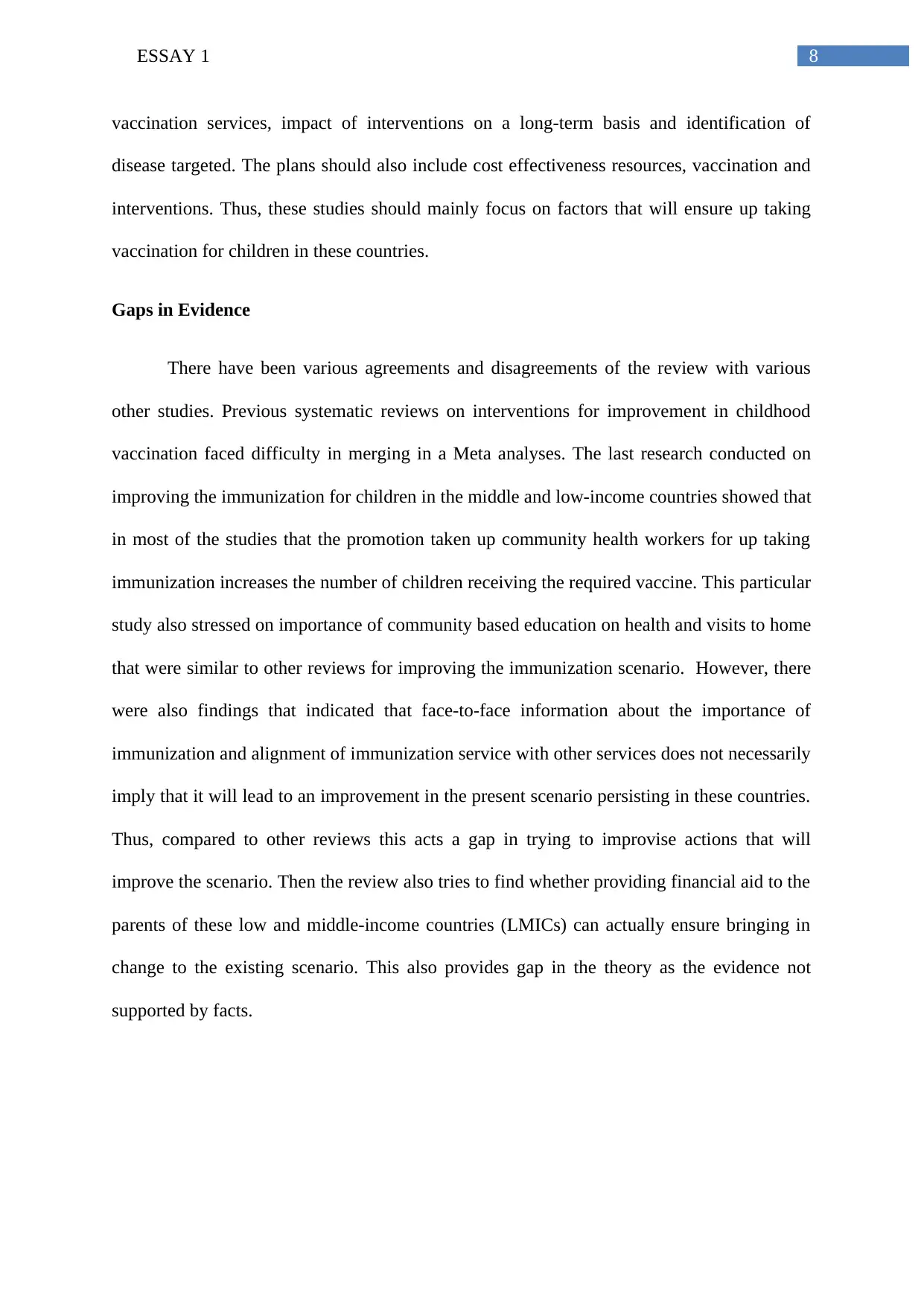
8ESSAY 1
vaccination services, impact of interventions on a long-term basis and identification of
disease targeted. The plans should also include cost effectiveness resources, vaccination and
interventions. Thus, these studies should mainly focus on factors that will ensure up taking
vaccination for children in these countries.
Gaps in Evidence
There have been various agreements and disagreements of the review with various
other studies. Previous systematic reviews on interventions for improvement in childhood
vaccination faced difficulty in merging in a Meta analyses. The last research conducted on
improving the immunization for children in the middle and low-income countries showed that
in most of the studies that the promotion taken up community health workers for up taking
immunization increases the number of children receiving the required vaccine. This particular
study also stressed on importance of community based education on health and visits to home
that were similar to other reviews for improving the immunization scenario. However, there
were also findings that indicated that face-to-face information about the importance of
immunization and alignment of immunization service with other services does not necessarily
imply that it will lead to an improvement in the present scenario persisting in these countries.
Thus, compared to other reviews this acts a gap in trying to improvise actions that will
improve the scenario. Then the review also tries to find whether providing financial aid to the
parents of these low and middle-income countries (LMICs) can actually ensure bringing in
change to the existing scenario. This also provides gap in the theory as the evidence not
supported by facts.
vaccination services, impact of interventions on a long-term basis and identification of
disease targeted. The plans should also include cost effectiveness resources, vaccination and
interventions. Thus, these studies should mainly focus on factors that will ensure up taking
vaccination for children in these countries.
Gaps in Evidence
There have been various agreements and disagreements of the review with various
other studies. Previous systematic reviews on interventions for improvement in childhood
vaccination faced difficulty in merging in a Meta analyses. The last research conducted on
improving the immunization for children in the middle and low-income countries showed that
in most of the studies that the promotion taken up community health workers for up taking
immunization increases the number of children receiving the required vaccine. This particular
study also stressed on importance of community based education on health and visits to home
that were similar to other reviews for improving the immunization scenario. However, there
were also findings that indicated that face-to-face information about the importance of
immunization and alignment of immunization service with other services does not necessarily
imply that it will lead to an improvement in the present scenario persisting in these countries.
Thus, compared to other reviews this acts a gap in trying to improvise actions that will
improve the scenario. Then the review also tries to find whether providing financial aid to the
parents of these low and middle-income countries (LMICs) can actually ensure bringing in
change to the existing scenario. This also provides gap in the theory as the evidence not
supported by facts.
⊘ This is a preview!⊘
Do you want full access?
Subscribe today to unlock all pages.

Trusted by 1+ million students worldwide
1 out of 9
Related Documents
Your All-in-One AI-Powered Toolkit for Academic Success.
+13062052269
info@desklib.com
Available 24*7 on WhatsApp / Email
![[object Object]](/_next/static/media/star-bottom.7253800d.svg)
Unlock your academic potential
Copyright © 2020–2025 A2Z Services. All Rights Reserved. Developed and managed by ZUCOL.





